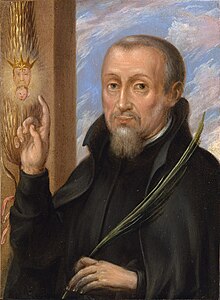Henry Garnet
| Henry Garnet | |
|---|---|
 |
|
| Details | |
| Parents | Brian Garnett, Alice Jay |
| Born | July 1555 Heanor, Derbyshire, England, UK |
| Occupation | Jesuit Superior in England |
| Plot | |
| Captured | 27 January 1606 |
| Conviction(s) | Treason |
| Penalty | Hanged, drawn and quartered |
| Died | 3 May 1606 St Paul's, London |
| Cause | Execution |
Henry Garnet (July 1555 – 3 May 1606), sometimes Henry Garnett, was an English Jesuit priest executed for his complicity in the Gunpowder Plot of 1605. Born in Heanor, Derbyshire, he was educated in Nottingham and later at Winchester College, before he moved to London in 1571, to work for a publisher. There he professed an interest in legal studies, and in 1575 he travelled to the continent and joined the Society of Jesus. He was ordained in Rome some time around 1582.
In 1586 Garnet returned to England as part of the Jesuit mission, soon succeeding Father William Weston as Jesuit superior, following the latter's capture by the English authorities. Garnet established a secret press, which lasted until late 1588, and in 1594 he interceded in the Wisbech Stirs, a dispute between secular and regular clergy. He preferred a passive approach to the problems Catholics faced in England, approving of the disclosure by Catholic priests of the existence of the 1603 Bye Plot, and exhorting English Catholics not to engage in violent rebellion.
In summer 1605 Garnet met with Robert Catesby, a religious zealot who, unknown to him, planned to kill the Protestant King James I. The existence of Catesby's Gunpowder Plot was revealed to him by Father Oswald Tesimond on 24 July 1605, but as the information was received under the seal of the confessional, he felt that Canon law prevented him from speaking out. Instead, without telling anyone of what Catesby planned, he wrote to his superiors in Rome, urging them to warn English Catholics against the use of force.
...
Wikipedia
